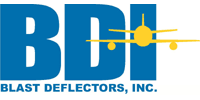The Airbus A380 is the largest commercial aircraft in the world and it flies in and out of the Sydney International Airport every day. So how do you protect hangars and buildings that are adjacent to the engine test area from high-power engine runs and high-velocity exhaust from this massive aircraft?
The Qantas maintenance facility had been able to perform safe engine tests in the past without endangering the surrounding area. With the new aircraft mix, however, a new solution had to be developed to upgrade the current run-up for the A380.
The Qantas maintenance facility utilised a unique run-up area design that allowed for the very high usability regardless of wind direction. By using a deflector built on a moving track system, the deflector could easily be moved behind the aircraft during engine tests. This flexibility allowed the aircraft to be positioned directly into the wind, which is the ideal condition for engine tests.
Qantas required a new deflector that utilised the existing track system. Blast Deflectors Inc, of Reno, Nevada, analysed the jet blast hazards created by the Qantas aircraft mix and provided a solution for Qantas. The new deflector was designed to be mounted Qantas-supplied trolleys that were positioned on the existing track system.
The challenge this project presented was to increase the height of the deflector without exceeding the limited footprint of the original deflector. A new deflector was required due to the larger blast envelope created by the Airbus A380, which also has outboard engines higher above ground level than a B747. Qantas required that the new deflector utilize the existing track system without modification. According to Don Bergin, director of technical sales for BDI, said: “We offer a range of deflectors suitable for all commercial aircraft. The height and configuration depend on the aircraft type and site-specific circumstance.”
“Standard deflectors for most wide-body aircraft with wing engines aircraft were 4.27m in the past. However, that height is generally not sufficient for newer aircraft such as the A380 and the B777 due to large blast envelopes of these aircraft.”
BDI addressed the situation by supplying a modified version of its G14M-3, which is a full-power-rated deflector. These deflectors were bolted on to carts supplied by Qantas. An aircraft tug or tractor can rotate the deflectors as required in order to provide optimal aircraft orientation.

